Dometic DOTRC17SSC, DOTRC17BC User Manual

OVER THE RANGE
MICROWAVE OVEN
OWNER’S
GUIDE
To help you get the most out of your new appliance
LISTED
MODEL NO.: DOTRC17BC DOTRC17SSC
3828W5A4380
French 3310144.000
P/N: 3828W5A4380

TABLE OF CONTENTS
TABLE OF CONTENTS ....................................... |
2 |
SAFETY................................................................ |
3 |
Important Safety Instructions ............................. |
3 |
PRECAUTIONS TO AVOID POSSIBLE |
|
EXPOSURE TO EXCESSIVE MICROWAVE |
|
ENERGY............................................................... |
4 |
INFORMATION..................................................... |
5 |
Location of Model Number................................. |
5 |
Oven Specifications ........................................... |
5 |
Electrical Requirements ..................................... |
5 |
Grounding Instructions ...................................... |
5 |
Microwave Oven Features ................................. |
6 |
Control Panel Features ...................................... |
7 |
MICROWAVE COOKING TIPS .......................... |
9 |
OPERATION ........................................................ |
14 |
Learn About Your Microwave Oven ................... |
14 |
Clock .................................................................. |
14 |
Child Lock .......................................................... |
14 |
Kitchen Timer..................................................... |
15 |
Vent Fan ............................................................ |
15 |
Vent Fan Auto Time Set .................................... |
15 |
Add 30 Sec. ...................................................... |
15 |
Turntable On/Off ................................................ |
16 |
Light On/Off........................................................ |
16 |
More/Less .......................................................... |
16 |
Custom Set ........................................................ |
16 |
Cooking at High Cook Power............................. |
16 |
Cooking at Lower Power Levels ........................ |
17 |
Cooking With More Than One Cook Cycle ........ |
17 |
Cooking Guide for Lower Power Levels............. |
18 |
Soften ................................................................ |
19 |
Soften Table ...................................................... |
19 |
Melt ................................................................... |
19 |
Melt Table .......................................................... |
19 |
Auto Defrost ....................................................... |
20 |
Weight Conversion Table .................................. |
20 |
Operating Tips .................................................. |
20 |
Auto Defrost Table ............................................. |
21 |
Defrosting Tips ................................................. |
23 |
Sensor Operating Instructions.......................... |
24 |
Sensor Cooking Guide ..................................... |
24 |
Sensor Popcorn ............................................... |
24 |
Sensor Cook .................................................... |
24 |
Sensor Reheat ................................................. |
24 |
Sensor Cook Table .......................................... |
25 |
Sensor Reheat Table ....................................... |
25 |
Auto Cook ........................................................ |
26 |
Auto Cook Table .............................................. |
26 |
Tips for Convection Cooking ............................ |
27 |
Convection ....................................................... |
28 |
Tips for Combination Cooking.......................... |
29 |
Helpful Hints for Combination Cooking ............ |
29 |
Combination .................................................... |
29 |
Speed Auto Combination ................................. |
30 |
Speed Auto Combination Chart ....................... |
30 |
COOKING ........................................................... |
31 |
Convection Baking Guidelines ......................... |
31 |
Meat Roasting Guidelines Convection |
|
Cooking ............................................................ |
33 |
Convection Roast Cooking Guide .................... |
34 |
Combination Bake Cooking Guide ................... |
35 |
Heating/Reheating Guide................................. |
36 |
Fresh Vegetable Guide .................................... |
37 |
MAINTENANCE.................................................. |
38 |
Caring for Your Microwave Oven ..................... |
38 |
Cleaning the Grease Filters ............................. |
39 |
Charcoal Filter Replacement............................ |
39 |
Cooktop/Countertop Light Replacement .......... |
40 |
Oven Light Replacement.................................. |
40 |
Questions and Answers ................................... |
40 |
Microwave Utensil Guide ................................. |
41 |
TROUBLESHOOTING........................................ |
42 |
Before Calling for Service ................................ |
42 |
WARRANTY ....................................................... |
43 |
- 2 -

SAFETY
IMPORTANT SAFETY INSTRUCTIONS
The safety instructions below will tell you how to use your oven and avoid harm to yourself or damage to your oven.
 WARNING - To reduce the risk of burns,
WARNING - To reduce the risk of burns,
electric shock, fire, injury to persons, or exposure to excessive microwave energy.
•Read all the instructions before using your oven.
•Do not allow children to use this oven without close supervision.
•Read and follow the specific PRECAUTIONS TO
AVOID POSSIBLE EXPOSURE TO EXCESSIVE MICROWAVE ENERGY found on page 4.
•Do not use corrosive chemicals or vapors, such as sulfide and chloride, in this appliance. This type of oven is specifically designed to heat, cook, or dry food. It is not designed for industrial or laboratory use.
•Do not use or store this appliance outdoors. Do not use this product near water - for example, near a kitchen sink, in a wet basement, or near a swimming pool, and the like.
•Do not use the cavity for storage purposes. Do not leave paper products, cooking utensils, or food in the cavity when not in use.
•Clean the ventilating hood frequently. Do not allow grease to accumulate on the hood or the filters.
•Use care when cleaning the vent hood filters. Corrosive cleaning agents such as lye-based oven cleaners may damage the filters.
•Do not tamper with the built-in safety switches on the oven door. The oven has several built-in safety switches to make sure the power is off when the door is open.
•When food flames under the hood, turn the fan on.
•Suitable for use above both gas and electric cooking equipment 36 inches wide or less.
•Do not use this oven for commercial purposes. It is made for household use only.
•When cleaning the door and the surfaces that touch the door, use only mild, non-abrasive soaps or detergents and a sponge or soft cloth.
•If your oven is dropped or damaged, have it thoroughly checked by a qualified service technician before using it again.
•To avoid a fire hazard:
-Do not severely overcook food. Severely overcooked foods can start a fire in the oven. Watch the oven carefully, especially if you have paper, plastic, or other combustibles in the oven.
-Do not store combustible items (bread, cookies, etc.) in the oven, because if lightning strikes the power lines it may cause the oven to turn on.
-Do not use wire twist-ties in the oven. Be sure to inspect purchased items for wire twist-ties and remove them before placing the item in the oven.
-If materials inside the oven ignite, keep the oven door closed, turn the oven off and disconnect the power cord, or shut off power at the fuse or circuit breaker panel. If the door is opened, the fire may spread.
•If a fire should start:
-Keep the oven door closed.
-Turn the oven off.
-Disconnect the power cord or shut off the power at the fuse or circuit breaker panel.
•To avoid electric shock:
-This appliance must be grounded. Connect it only to a properly grounded outlet. See the electrical
GROUNDING INSTRUCTIONS on page 5.
-Do not operate this appliance if it has a damaged cord or plug, if it is not working properly or if it has been damaged or dropped.
-Do not immerse the electrical cord or plug in water.
-Keep the cord away from heated surfaces.
- 3 -

SAFETY
• To avoid improperly cooking some foods. |
• Preserve the oven floor: |
|
- Do not heat any types of baby bottles or baby |
- Do not heat the oven floor excessively. |
|
food. Uneven heating may occur and possibly |
- Do not allow the gray film on special microwave- |
|
cause personal injury. |
cooking packages to touch the oven floor. Put |
|
- Do not heat small-necked containers, such as |
the package on a microwavable dish. |
|
syrup bottles. |
- Do not cook anything directly on the oven floor or |
|
- Do not deep-fat fry in your microwave oven. |
glass turntable. Use a microwavable dish. |
|
- Do not attempt home canning in your |
- Keep a browning dish at least 3/16 inch above |
|
microwave oven. |
floor. Carefully read and follow the instructions for |
|
- Do not heat the following items in the |
the browning dish. If you use a browning dish |
|
microwave oven: whole eggs in the shell, water |
ncorrectly, you could damage the oven floor. |
|
with oil or fat, sealed containers, or closed glass |
• Install or locate this appliance only in accordance |
|
jars. These items may explode. |
with the provided installation instructions. |
|
• Do not cover or block any openings in the oven. |
• This appliance should be serviced only by |
|
• Use your oven only for the operations described in |
qualified service personnel. Contact the nearest |
|
this manual. |
authorized service facility for examination, repair, |
|
• Do not run the oven empty, without food in it. |
or adjustment. |
|
• As with any appliance, close supervision is |
||
• Do not let cord hang over edge of table or counter. |
||
necessary when used by children. |
||
|
||
|
|
PRECAUTIONS TO AVOID POSSIBLE
EXPOSURE TO EXCESSIVE
MICROWAVE ENERGY...
(a)Do not attempt to operate this oven with the door open since open-door operation can result in harmful exposure to microwave energy. It is important not to defeat or tamper with the safety interlocks.
(b)Do not place any object between the oven front face and the door or allow soil or cleaner residue to accumulate on sealing surfaces.
(c)Do not operate the oven if it is damaged.
It is particularly important that the oven door closes properly and that there is no damage to the:
(1)Door (bent),
(2)Hinges and latches (broken or loosened),
(3)Door seals and sealing surfaces.
(d)The oven should not be adjusted or repaired by anyone except properly qualified service personnel.
- 4 -
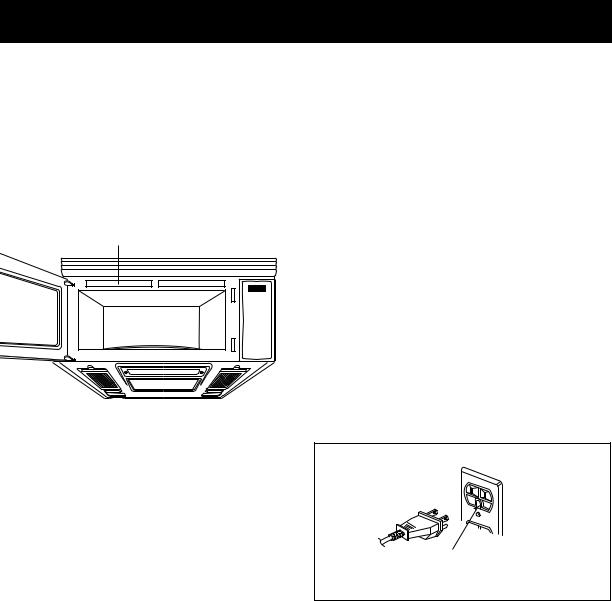
INFORMATION
Please read this owner’s manual. It will tell you how to use all the fine features of this microwave oven.
LOCATION OF MODEL NUMBER
To request service information or replacement parts, the service center will require the complete model number of your microwave oven. The number is on the oven front as shown in the illustration below.
OVEN SPECIFICATIONS
GROUNDING INSTRUCTIONS
This appliance must be grounded. If an electrical short circuit occurs, grounding reduces the risk of electric shock by providing an escape wire for the electric current. The cord for this appliance has a grounding wire with a grounding plug. Put the plug into an outlet that is properly installed and grounded.
 WARNING - If you use the grounding plug improperly, you risk electric shock.
WARNING - If you use the grounding plug improperly, you risk electric shock.
MODEL NUMBER LABEL
Power Supply |
|
|
|
120V AC, 60 Hz |
|
|
|
|||
|
|
|
|
|
|
|
|
|
|
|
Rated Power |
Microwave |
|
|
|
|
1500W |
|
|
|
|
|
|
|
|
|
|
|
|
|
|
|
Consumption |
Convection |
|
|
|
|
1500W |
|
|
|
|
|
|
|
|
|
|
|
|
|
|
|
Power Output |
Microwave |
|
|
|
|
*850W |
|
|
|
|
|
|
|
|
|
|
|
|
|
|
|
|
Convection |
|
|
|
|
1350W |
|
|
|
|
|
|
|
|
|
|
|
|
|
|
|
Rated Current |
Microwave |
|
|
|
|
12.0A |
|
|
|
|
|
|
|
|
|
|
|
|
|
|
|
|
Convection |
|
|
|
|
12.0A |
|
|
|
|
|
|
|
|
|
|
|
|
|
||
Overall Dimensions(WxHxD) |
29 |
15/ |
16 |
" x 16 |
7/ " x 15 |
3/ |
" |
|||
|
|
|
|
|
|
16 |
|
8 |
|
|
Oven Cavity Dimensions |
21 |
1/ " x 9 7/ |
" x 14 3/ |
16 |
" |
|
||||
|
|
|
|
|
4 |
|
16 |
|
|
|
(WxHxD) |
|
|
|
|
|
|
|
|
|
|
|
|
|
|
|
|
|
|
|
|
|
Capacity of Oven Cavity |
|
|
|
|
1.7 cu.ft |
|
|
|
||
|
|
|
|
|
|
|
|
|
|
|
ELECTRICAL REQUIREMENTS
The oven is designed to operate on a Standard 120V/60Hz household outlet. Be sure the circuit is at least 15A or 20A and the microwave oven is the only appliance on the circuit. It is not designed for 50Hz or any circuit other than a 120V/60Hz circuit.
Ask a qualified electrician if you do not understand the grounding instructions or if you wonder whether the appliance is properly grounded.
Because this appliance fits under the cabinet, it has a short power-supply cord. See the separate Installation Instructions for directions on placing the cord properly. Keep the electrical power cord dry and do not pinch or crush it in any way.
If it is necessary to use an extension cord, use only a 3-wire extension cord that has a 3-blade grounding plug, and a 3-slot receptacle that will accept the plug on the appliance. The marked rating of the extension cord shall be equal to or greater than the electrical rating of the appliance.
Ensure proper ground exists before use
For a permanently connected appliance:
This appliance must be connected to a grounded, metallic, permanent wiring system, or an equipment grounding conductor should be run with the circuit conductors and connected to the equipment grounding terminal or lead on the appliance.
- 5 -
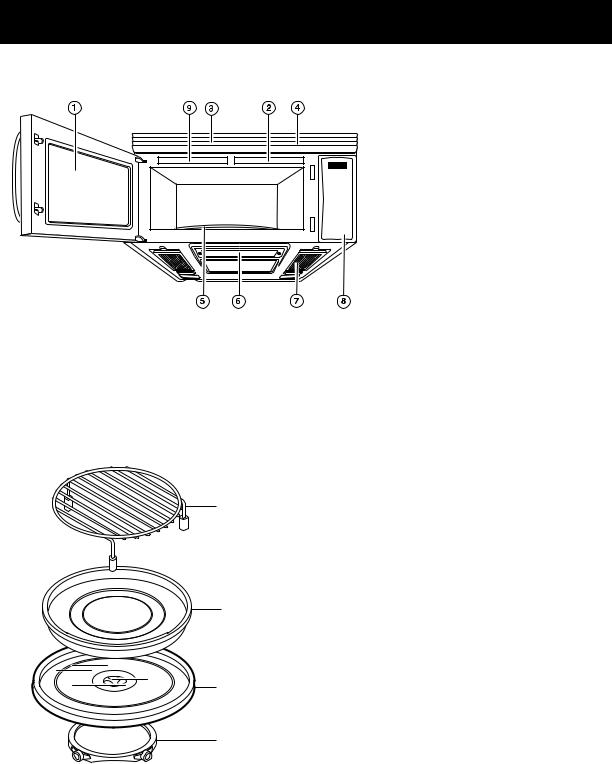
INFORMATION
MICROWAVE OVEN FEATURES
Your microwave oven is designed to make your cooking experience as enjoyable and productive as possible.
To get you up and running quickly, the following is a list of the oven’s basic features:
1.Metal Shielded Window The shield prevents microwaves from escaping. It is designed as a screen to allow you to view food as it cooks.
2.Cooking Guide Label
3.Charcoal Filter (behind Vent Grille)
4.Vent Grille
5.Glass Tray The glass tray moves food as it cooks for more even cooking. It must be in the oven during operation.
6.Cooktop Light
7.Grease Filter
8.Control Panel Touch the pads on this panel to perform all functions.
9.Model and Serial Number Plate
1
2
3
4
1.Convection Rack
2.Metal Tray/Drip Pan
3.Glass Turntable
4.Rotating Ring
The glass turntable rotates in both direction to help food cook more evenly. Do not operate the microwave oven without the glass tray in place.
- 6 -
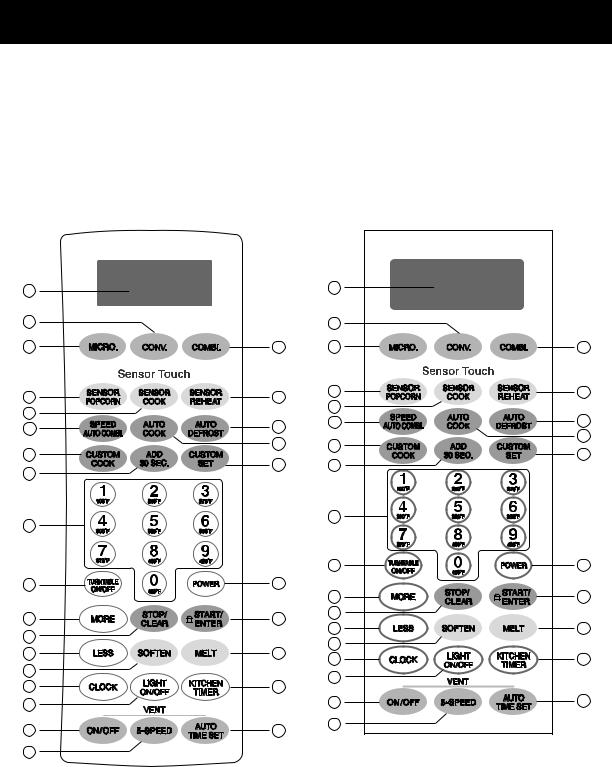
INFORMATION
CONTROL PANEL FEATURES
Your microwave oven control panel lets you select the desired cooking function quickly and easily. All you have to do is touch the necessary Command Pad. The following is a list of all the Command and Number Pads located on the control panel. For more information on these features, see OPERATION section.
1 |
|
1 |
|
|
3 |
|
3 |
|
|
2 |
4 |
2 |
4 |
|
5 |
7 |
5 |
7 |
|
6 |
|
|||
6 |
|
10 |
||
10 |
8 |
|||
8 |
||||
|
9 |
|||
|
9 |
11 |
||
11 |
13 |
|||
13 |
12 |
|||
12 |
|
|||
|
|
|
||
14 |
|
14 |
|
|
|
|
|
||
|
|
15 |
16 |
|
15 |
16 |
17 |
19 |
|
|
|
|||
17 |
19 |
18 |
|
|
20 |
22 |
|||
18 |
|
|||
|
21 |
|
||
20 |
22 |
|
||
23 |
25 |
|||
21 |
|
|||
|
24 |
|
||
23 |
25 |
|
||
|
28 |
|||
24 |
|
26 |
||
26 |
28 |
27 |
|
|
|
|
|||
27 |
|
|
|
|
DOTRC17BC |
|
|
DOTRC17SSC |
|
|
|
- 7 - |
|

INFORMATION
1.DISPLAY: The Display includes a clock and indicators to tell you time of day, cooking time settings, and cooking functions selected.
2.MICRO.: Touch this pad when setting Microwave cooking.
3.CONV.: Touch this pad when setting Convection cooking.
4.COMBI.: Touch this pad when setting combination cooking or preheat.
5.SENSOR POPCORN: Touch this pad when popping popcorn in your microwave oven. The oven’s sensor will tell the oven how long to cook depending on the amount of humidity it detects from the popcorn.
6.SENSOR COOK: Touch this pad to cook baked potato, frozen vegetable, fresh vegetable, canned vegetable, frozen entrée, and rice. The oven’s sensor will tell the oven how long to cook depending on the amount of humidity coming from the food.
7.SENSOR REHEAT: Touch this pad to reheat casserole, dinner plate, pizza slice, and soup/sauce. The oven’s sensor will tell the oven how long to cook depending on the amount of humidity coming from the food.
8.SPEED AUTO COMBI: Touch this pad when setting weight combination cooking.
9.AUTO COOK: Touch this pad to cook Bacon, Fresh Roll & Muffin, Frozen Roll & Muffin, Beverage, Chicken Pieces, and Hot Cereal.
10.AUTO DEFROST: Touch this pad to select food type and defrost food by weight.
11.CUSTOM COOK: Touch this pad to recall one cooking instruction previously programmed into memory.
12.ADD 30 SEC.: Touch this pad to set 100% power level on microwave cooking.
13.CUSTOM SET: Touch this pad to change the oven’s default settings for sound, clock, display speed, and defrost weight.
14.NUMBER: Touch number pads to enter cooking time, power level, quantities, weights, or cooking temperature.
15.TURNTABLE ON/OFF: Touch this pad to turn off the glass turntable. OFF will appear in the display. NOTE: This option is not available in sensor cook and defrost modes.
16.POWER: Touch this pad to select a cooking power level.
17.MORE: Touch this pad to add ten seconds of cooking time each time you press it.
18.STOP/CLEAR: Touch this pad to stop the oven or to clear all entries.
19.START/ENTER: Touch this pad to start a function or enter all entries. If you open the door after oven begins to cook, touch START/ENTER again.
20.LESS: Touch this pad to subtract ten seconds of cooking time each time you press it.
21.SOFTEN: Touch this pad to soften Butter, Ice Cream, Cream Cheese, or Frozen Juice.
22.MELT: Touch this pad to melt Butter or Margarine, Chocolate, Cheese, or Marshmallow.
23.CLOCK: Touch this pad to enter the time of day.
24.LIGHT ON/OFF: Touch this pad to turn the cooktop/ countertop light on or off.
25.KITCHEN TIMER: Touch this pad to set the timer.
26.VENT ON/OFF: Touch this pad to turn the fan on/off.
27.VENT 5-SPEED: Touch this pad to choose one of 5 fan speeds.
28.VENT AUTO TIME SET: Touch this pad when setting ventilation time. (1, 3, 5, 10, and 30 minutes.)
- 8 -

MICROWAVE COOKING TIPS
Amount of food
•If you increase or decrease the amount of food you prepare, the time it takes to cook that food will also change. For example, if you double a recipe, add a little more than half the original cooking time. Check for doneness and, if necessary, add more time in small increments.
Starting temperature of food
•The lower the temperature of the food being put into the microwave oven, the longer it takes to cook. Food at room temperature will be re-heated more quickly than food at refrigerator temperature.
Composition of food
•Food with a lot of fat and sugar will be heated faster than food containing a lot of water. Fat and sugar will also reach a higher temperature than water in the cooking process.
•The more dense the food, the longer it takes to heat. Very dense food like meat takes longer to heat than lighter, more porous food like sponge cakes.
Size and shape
•Smaller pieces of food will cook faster than larger pieces. Also, same-shaped pieces cook more evenly than different-shaped pieces.
•With foods that have different thicknesses, the thinner parts will cook faster than the thicker parts. Place the thinner parts of chicken wings and legs in the center of the dish.
Stirring, turning foods
•Stirring and turning foods spreads heat quickly to the center of the dish and avoids overcooking at the outer edges of the food.
Covering food
Cover food to:
•Reduce splattering
•Shorten cooking times
•Keep food moist
Releasing pressure in foods
•Several foods (for example: baked potatoes, sausages, egg yolks, and some fruits) are tightly covered by a skin or membrane. Steam can build up under the membrane during cooking, causing the food to burst. To relieve the pressure and to prevent bursting, pierce these foods before cooking with a fork, cocktail pick, or toothpick.
Using standing time
•Always allow food to stand either in or out of the oven after cooking power stops. Standing time after defrosting and cooking allows the temperature to evenly spread throughout the food, improving the cooking results. For inside oven standing time, you can program a 0 power second stage of the cooking cycle. See cooking with more than on cook cycle cooking.
•The length of the standing time depends on how much food you are cooking and how dense it is. Sometimes it can be as short as the time it takes you to remove the food from the oven and take it to the serving table. However, with larger, denser food item, the standing time may be as long as 10 minutes.
Arranging food
For best results, place food evenly on the plate. You can do this in several ways:
•If you are cooking several items of the same food, such as baked potatoes, place them in a ring pattern for uniform cooking.
•When cooking foods of uneven shapes or thickness, such as chicken breasts, place the smaller or thinner area of the food towards the center of the dish where it will be heated last.
•Layer thin slices of meat on top of each other.
•When you cook or reheat whole fish, score the skin – this prevents cracking.
•Do not let food or a container touch the top or sides of the oven. This will prevent possible arcing.
- 9 -
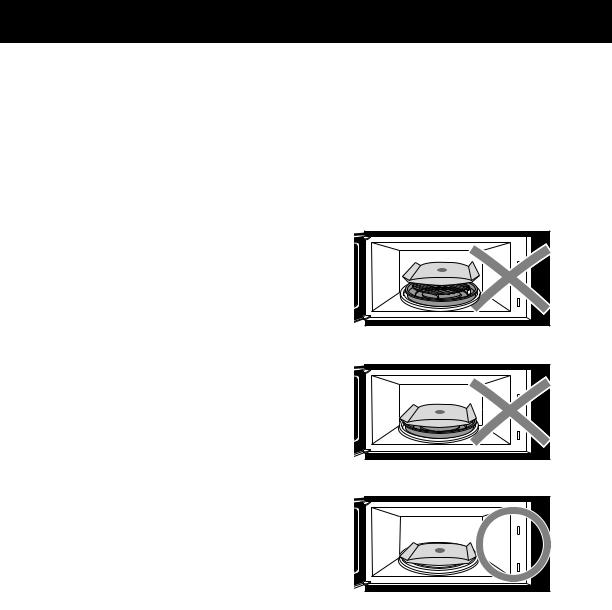
MICROWAVE COOKING TIPS
Using aluminum foil
Metal containers should not be used in a microwave oven. There are, however, some exceptions. If you have purchased food which is prepackaged in an aluminum foil container, refer to the instructions on the package. When using aluminum foil containers, cooking times may be longer because microwaves will only penetrate the exposed top of the food and not the bottom or the sides. If you use aluminum containers without package instructions, follow these guidelines:
•Place the aluminum foil container in a glass bowl and add some Water so that it covers the bottom of the container, but not more than 1/4 in. (.64 cm) deep. This ensures even heating of the container bottom.
•Always remove the container lid to avoid damage to the oven.
•Use only undamaged containers.
•Do not use containers taller than 3⁄4 in. (1.9 cm).
•Container must be at least half filled.
•To avoid arcing, there must be a minimum 1⁄4 in. (64 mm) between the aluminum container and the walls of the oven and also between two aluminum containers.
•Always place the container on the glass turntable.
•Shield parts of food that may cook quickly, such as wing tips and leg ends of poultry, with small pieces of aluminum foil.
•Heating food in aluminum foil containers usually takes up to double the time compared to reheating in plastic, glass, china, or paper containers.
The time when food is ready will vary depending upon the type of container you use.
•Let food stand for 2 to 3 minutes after heating so that heat is spread evenly throughout the container.
Cooking you should not do in your microwave oven
•Do not do canning of foods in the oven. Closed glass jars may explode, resulting in damage to the oven.
•Do not use the microwave oven to sterilize objects (baby bottles, etc.). It is difficult to keep the oven at the high temperature needed for sterilization.
Removing the rack
• When popping commercially packaged popcorn,
Remove the rack and drip pan from the oven; Do not place the bag of microwave popcorn on the rack or under the rack. Leave the glass tray in place at all times.
CAUTION : Popping microwave popcorn with rack and drip pan can cause fire or damage to your microwave oven.
- 10 -

MICROWAVE COOKING TIPS
Cooking Comparison Guide
Cooking with your new oven offers a wide variety of food preparation options: microwave cooking, convection cooking, and combination cooking. Microwave cooking uses very short, high-frequency radio waves. The movement of the microwaves through the food generates heat and cooks most foods faster than regular methods, while retaining their natural texture and moisture. Microwave cooking heats food directly, not the cookware or the interior of the oven. Reheating is easy and defrosting is particularly convenient because less time is spent in food preparation.
Convection cooking constantly circulates heated air around the food, creating even browning and sealed-in flavor by the constant motion of hot air over the food surfaces.
Combination cooking combines microwave energy with convection to cook with speed and accuracy, while browning and crisping to perfection.
You can use microwave cooking, convection cooking, or combination cooking to cook by time. Simply preset the length of cooking time desired and your oven turns off automatically.
The following guide shows at a glance the difference between microwave, convection, and combination cooking.
MICROWAVE |
CONVECTION |
COMBINATION |
COOKING |
|
|
|
|
|
|
|
|
|
|
|
|
|
|
|
|
|
|
|
|
|
|
|
|
|
|
|
|
|
|
|
|
|
|
|
|
|
|
|
|
|
|
|
|
|
|
|
|
|
|
|
|
|
|
|
|
|
|
|
|
|
|
|
METHOD |
Microwave energy is |
Hot air circulates around |
Microwave energy and |
||||||||||||
|
distributed evenly |
food to produce browned |
convection heat combine to |
||||||||||||
|
throughout the oven for fast, |
exteriors and sealed-in |
shorten the cooking time of |
||||||||||||
|
thorough cooking of food. |
juices. |
regular ovens, while |
||||||||||||
|
|
|
|
|
|
|
|
|
|
|
browning and sealing in |
||||
|
|
|
|
|
|
|
|
|
|
|
juices. |
||||
|
|
|
|
|
|
|
|
|
|
|
|
|
|
|
|
HEAT SOURCE |
Microwave energy. |
Circulating heated air. |
Microwave energy and |
||||||||||||
|
|
|
|
|
|
|
|
|
|
circulating heated air. |
|||||
|
|
|
|
|
|
|
|
|
|
|
|||||
|
|
|
|
|
|
|
|
|
|
|
|
|
|
|
|
|
• Fast, high efficiency |
• Aids in browning and seals |
• Shortened cooking time |
||||||||||||
|
cooking. |
in flavor. |
from microwave energy. |
||||||||||||
BENEFITS |
• Oven and surroundings |
• Cooks some foods faster |
• Browning and crisping |
||||||||||||
|
do not get hot. |
than regular ovens. |
from convection heat. |
||||||||||||
|
• Easy clean-up. |
|
|
|
|
|
|
|
|
|
|
||||
Read this guide to learn the many different things your Microwave/Convection/Combination Oven can do. You will find a wide variety of cooking methods and programs designed to suit your lifestyle.
- 11 -

MICROWAVE COOKING TIPS
COOKWARE GUIDE
Microwave Cooking
Most heat-resistant, non-metallic cookware is safe for use in your microwave oven.
To test cookware before using, follow these steps:
1.Place the empty cookware in the microwave oven.
2.Measure 1 cup of water in a glass measuring cup and place it in the oven beside the cookware.
3.Microwave on 100% power for 1 minute. If the dish is warm, it should not be used for microwave cooking.
•Glass or glass-ceramic baking containers are recommended. Be sure not to use items with metal trim as it may cause arcing (sparking) with oven wall or oven shelf, damaging the cookware, the shelf, or the oven.
•Heat-resistant plastic microwave cookware (safe to 450°F) may be used, but is not recommended for foods that require crusting or all-around browning, because plastic is a poor conductor of heat.
Convection Cooking
•Metal Pans are recommended for all types of baked products, but especially where browning or crusting is important.
•Dark or dull finish metal pans are best for breads and pies because they absorb heat and produce a crisper crust.
•Shiny aluminum pans are better for cakes, cookies, or muffins because these pans reflect heat and help produce a light, tender crust.
•Glass or glass-ceramic casserole or baking dishes are best suited for egg and cheese recipes due to the cleanability of glass.
Combination Cooking
COOKWARE |
MICROWAVE |
CONVECTION |
COMBINATION |
|
|
|
|
Heat-Resistant Glass, Ceramic Glass |
Yes |
Yes |
Yes |
|
|
|
|
Ceramics, China |
Yes |
Yes |
Yes |
|
(Do not use china |
|
|
|
with gold or silver trim.) |
|
|
|
|
|
|
Metal Cookware |
No |
Yes |
No |
|
|
|
|
Non Heat-Resistant Glass |
No |
No |
No |
|
|
|
|
Microwave-Safe Plastic |
Yes |
No |
Yes* |
|
|
|
|
Plastic Wrap, Wax Paper |
Yes |
No |
No |
|
|
|
|
Paper Products |
Yes |
No |
No |
|
|
|
|
Straw, Wicker, and Wood |
Yes |
No |
No |
|
|
|
|
* Use only microwave cookware that is safe to 450°F
- 12 -
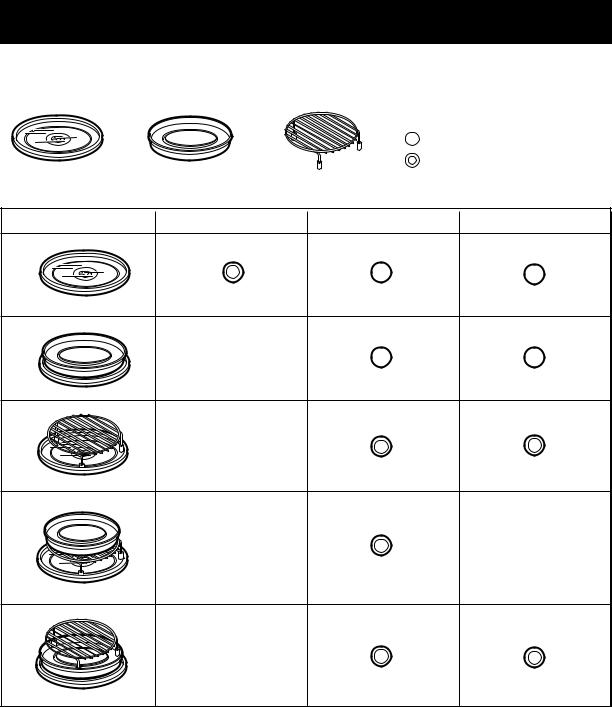
MICROWAVE COOKING TIPS
HOW TO USE ACCESSORIES
|
|
: Possible to use |
|
|
|
: Recommended method |
|
Glass Turntable Metal Tray/Drip pan Convection Rack |
X : Do not use |
||
MICROWAVE |
CONVECTION |
COMBINATION |
|
X
X
X |
X |
X
Notes :
•Do not operate the oven except when it is preheating in the convection mode only. NEVER operate the microwave while the oven is empty.
- 13 -
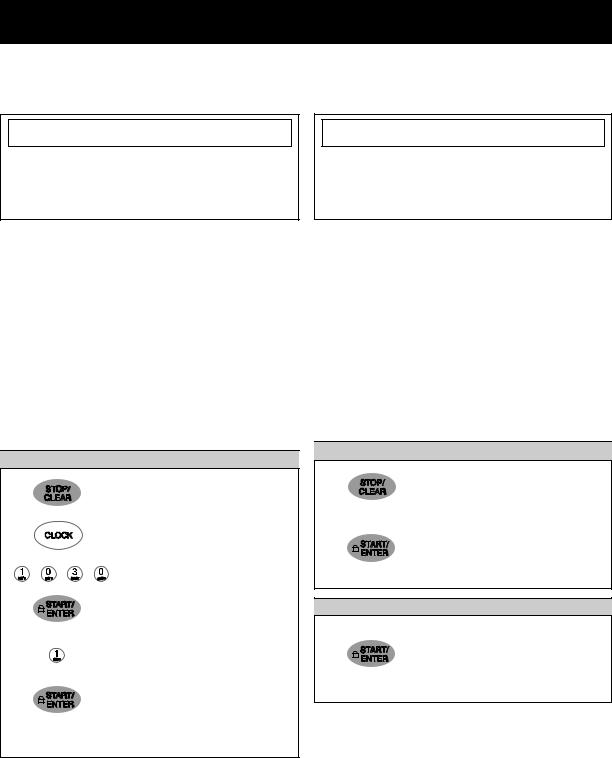
OPERATION
LEARN ABOUT YOUR MICROWAVE OVEN
This section discusses the concepts behind microwave cooking and introduces you to the basics you need to know to operate your microwave oven. Please read this information before use.
 CAUTION
CAUTION
To avoid risk of personal injury or property damage, do not use
stoneware, aluminum foil, metal utensils, or metal trimmed utensils in the oven.
 CAUTION
CAUTION
To avoid risk of personal injury
or property damage, do not run oven empty.
AUDIBLE SIGNALS
Audible signals are available to guide you when setting and using your oven:
•A tone will sound each time you touch a pad.
•Seven tones signal the end of a Timer countdown.
•Four tones signal the end of a cooking cycle.
CLOCK
When your microwave oven is first plugged in or after a power failure, the Display will show PLEASE SET TIME OF DAY. If a time of day is not set, : (a colon) will show on the Display until you touch CLOCK.
Example: To set the clock for 10:30(AM).
1. Touch STOP/CLEAR.
2. Touch CLOCK.
3. Enter the time by using the number key pad.
4. Touch START/ENTER.
5. Touch 1. (Press 1 for AM, Press 2 for PM)
6. Touch START/ENTER.
NOTES:
•If you enter in an incorrect time and touch CLOCK, you cannot set time of day. Enter the correct time.
•If you touch STOP/CLEAR while setting the clock, the Display will show the last time of day set or : (a colon) if no time of day has been set.
INTERRUPTING COOKING
You can stop the oven during a cycle by opening the door. The oven stops heating and the fan stops, but the light stays on. To restart cooking, close the door and Touch START/ENTER.
If you do not want to continue cooking, open the door and touch STOP/Clear.
CHILD LOCK
Use this safety feature to lock the control panel when you are cleaning the oven, or so children cannot use the oven unsupervised.
Example: To set the child lock.
1. Touch STOP/CLEAR.
2.Touch and hold
START/ENTER more than
4 seconds. LOCKED will appear in the display window with two beeps.
Example: To cancel the child lock.
1.Touch and hold
START/ENTER more than
4 seconds. LOCKED will disappear and you hear two beeps.
- 14 -
